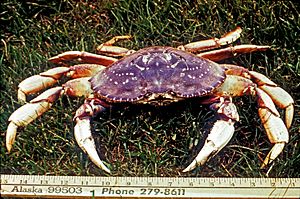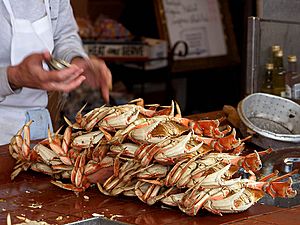Dungeness crab facts for kids
Quick facts for kids Dungeness crab |
|
|---|---|
 |
|
| Dungeness crab measuring 17 cm (6.7 in) | |
| Scientific classification | |
| Synonyms | |
|
Cancer magister Dana, 1852 |
The Dungeness crab is a type of crab found along the west coast of North America. These crabs live in eelgrass beds and on the ocean floor. They can grow up to 20 cm (7.9 in) wide across their shell. Dungeness crabs are a very popular seafood. Their name comes from a place called Dungeness, Washington, in the United States. This area is known for its valuable crab fishing.
Contents
What is a Dungeness Crab?
Dungeness crabs have a wide, hard carapace (shell). This shell can grow up to 25 centimetres (9.8 in) wide in some places off the coast of Washington. However, most are usually smaller than 20 cm (7.9 in). To grow bigger, the crab must shed its old shell. This process is called molting.
These crabs have five pairs of legs. Their front pair of legs has strong claws. They use these claws for defense and to tear apart their food. Smaller appendages (body parts) help them move food into their mouth. Inside the crab's stomach, a special "gastric mill" helps break down food even more. Dungeness crabs can also bury themselves completely in the sand if they feel threatened.
-
A close-up of the crab's head. You can see its two eyes on stalks and two small feelers called antennules.
What Do Dungeness Crabs Eat?
Dungeness crabs enjoy eating clams, other crustaceans (like shrimp), and small fish. They are also good scavengers, meaning they eat dead plants and animals. Sometimes, they might even eat other Dungeness crabs!
Life Cycle of the Dungeness Crab
Female crabs usually molt (shed their shells) between May and August. Right after molting, before their new shell gets hard, they mate. Male crabs find females by sensing special chemicals called pheromones in the female's urine.
Several months after mating, the female lays her eggs. The eggs stay attached under her abdomen (belly) for three to five months until they hatch. When young crabs hatch, they are tiny and free-swimming. They go through five different larval stages before they become mature crabs. This usually takes about 10 molts or two years.
Young crabs often grow up in eelgrass beds and estuaries (where rivers meet the sea). The water in these areas is less salty. This lower salt level helps protect the young crabs from tiny worms that can harm their eggs.
Where Do Dungeness Crabs Live?
The Dungeness crab is named after Dungeness, Washington. This town is about 5 miles (8.0 km) north of Sequim. Their usual home stretches from Alaska's Aleutian Islands all the way down to Point Conception in California. Sometimes, they are even found as far south as Magdalena Bay in Mexico.
Scientists have studied the genes of Dungeness crabs. They found that crabs along the California Current System are part of one big group. However, ocean conditions like currents can change how young crabs spread out each year. This affects the genetic diversity of crabs in different areas.
Dungeness Crab as Food

Dungeness crabs are a popular food in the United States and Canada. Long ago, before Europeans arrived, Native American peoples along the coast ate these crabs as a traditional part of their diet. They would gather them at low tide. The meat of the Dungeness crab is known for its delicate and slightly sweet taste.
Today, Dungeness crabs are a big part of the food culture in California, British Columbia, and the Pacific Northwest. They are often used in dishes like Crab Louie or Cioppino. About one-quarter of a crab's total weight is delicious meat!
How to Prepare Dungeness Crab
You can usually buy Dungeness crabs either live or already cooked. If you buy a live crab, you can cook it by dropping it into boiling salty water. Let the water boil again, then cook for about 15 minutes. After that, put the crab into cold water to cool it down, then clean it.
Another way to prepare crab is called "half backing." You flip the crab over and cut it in half from head to "tail." Then, you can scoop or hose out the guts and gills. Many people think half backing is better because the meat doesn't get the flavor or toxins from the guts. Plus, half-backed crabs cook faster!
To get the meat out of the shell, people often use a crab cracker and a shrimp fork. Sometimes, people use a cleaver or a small hammer, but this is not recommended. It can damage the meat.
Is Dungeness Crab Fishing Sustainable?
Seafood Watch is a program that helps people choose seafood that is caught or farmed in ways that don't harm the environment. They have given the Dungeness crab a 'Good Alternative' rating. This means it's a good choice compared to seafood from overfished species or farms that hurt marine life.
In 2014, fishermen caught 53 million pounds of Dungeness crab, worth $170 million! However, a 2020 study by NOAA showed a concern. Young crab larvae are being affected by ocean acidification. This happens when the ocean's pH level drops, making the water more acidic.
Oregon's State Crustacean
In 2009, some schoolchildren from Sunset Primary School in West Linn, Oregon, worked hard to make the Dungeness crab special. They lobbied the Oregon Legislative Assembly to recognize its importance to Oregon's economy. Because of their efforts, the Dungeness crab was officially named the state crustacean of Oregon!
See also
 In Spanish: Cangrejo dungeness para niños
In Spanish: Cangrejo dungeness para niños




